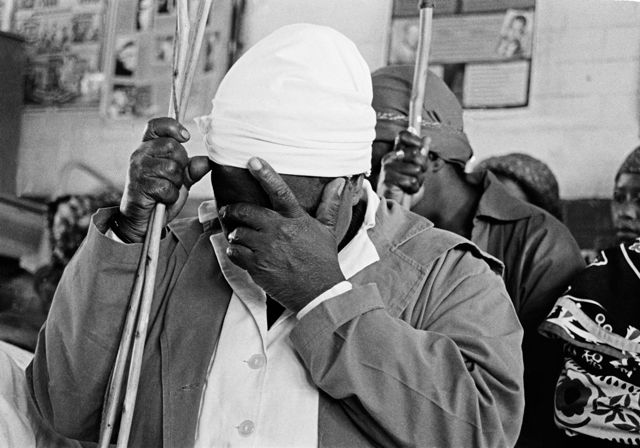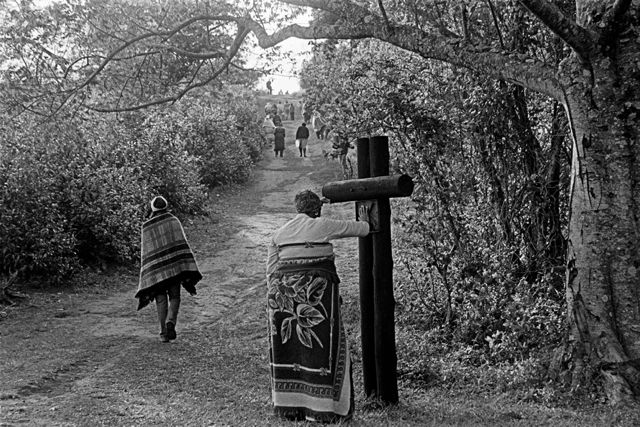C& est partenaire médiatique de l'exposition “The Divine Comedy: Heaven, Hell, Purgatory revisited by Contemporary African Artists” au MMK, musée d'art modern. Conçue de façon à part entière avec l'événement, C& propose une série de conversations inédites avec les artistes participants.

Andrew Tshabangu, Praying, 2003, 40 x 50 cm. Courtesy of the artist and Gallery MOMO, Johannesburg
MMK/C& : Le point de départ de l’exposition est la « Divine Comédie » de Dante. Dans quelle mesure avez-vous véritablement travaillé sur l’œuvre de Dante pendant la préparation à l’exposition?
Andrew Tshabangu: Etant donné que les oeuvres proposées dans le cadre de cette exposition ont été réalisées sur une période de plus de 15 ans et qu’elles se concentraient sur les pratiques religieuses en Afrique du Sud et en Réunion, une telle préparation n’était pas vraiment pertinente. Avant d’être invité à participer à cette exposition, je n’avais jamais entendu parler de Dante et je ne connaissais aucune de ses œuvres. Lorsque j’ai reçu l’invitation, j’ai commencé à faire des recherches et j’aime surtout sa poésie, en particulier la « Divine Comédie ».
MMK/C& : En fusionnant les croyances chrétiennes et les valeurs morales ainsi que les thèmes païens classiques, la « Divine Comédie » représente un concept de société, des valeurs et une culture profondément enracinés dans l’eurocentrisme. L’exposition a pour objectif de démanteler la prérogative d’interprétation européenne et de la considérer sous un autre angle. Dans quelle mesure pensez-vous que cette approche puisse aboutir à une remise en question générale de la souveraineté de l’interprétation euro-centrique?
AT: En tant que photographe, je suis tout d’abord un être social et c’est mon être qui détermine ma conscience. Ce que je veux dire, c’est que mon être détermine l’image que j’ai de moi-même et la perception que j’ai de l’environnement dans lequel je vis. Ce sont les relations que j’entretiens avec d’autres êtres humains qui influencent mon travail.
J’espère que les photos que je produis suscitent un écho chez les spectateurs et que l’œuvre se transforme en une source intarissable d’inspiration, de joie et d’éducation. En d’autres termes, j’aimerais que mon travail suscite une expérience qui permette d’atteindre une satisfaction plus profonde, plus intense et plus large afin qu’à l’issue de cette rencontre, l’observateur en ressorte grandi et puisse y trouver un nouveau sens.
La meilleure façon d’illustrer ce point est de dresser l’esquisse du processus que je suis quand je fais des photos. Mon travail photographique est alimenté par le fait que la réalité est truffée d’éléments conflictuels qui co-existent et sont à la source d’une réalité où règnent le chaos et le désordre. La photographie me permet d’imposer un ordre face au désordre qui m’entoure. Je réfléchis tout d’abord à tous les éléments conflictuels et je développe ensuite une idée clé qui exprime au mieux un concept unique sans pour autant fausser les différences. Je rejette certaines caractéristiques de l’environnement mais j’en accepte aussi d’autres afin de pouvoir saisir et présenter mon idée de base.
Je suis convaincu du fait que mon oeuvre ne peut être bien interprétée que dans le contexte qui motive mon travail. En tant que photographe, mon rôle dans la société n’est pas de lui présenter ce qu’elle connaît déjà ; je me vois plutôt dans le rôle d’une antenne sensible qui permet à la société de prendre conscience d’elle-même, de ses désirs, de ses rêves, de ses avortements et fausses couches, de son passé, de son présent et de ce qu’elle aimerait devenir à l’avenir. En qualité de photographe, j’ai un travail solitaire comme celui de l’écrivain mais l’humanité y tient une place centrale.
MMK/C& : Dans l’histoire de l’art du Nord de l’Europe et de l’Amérique, la « Divine Comédie » a été interprétée par de nombreux artistes (tels que Botticelli, Delacroix, Blake, Rodin, Dalí ou Robert Rauschenberg) – dans quelle mesure cela a-t-il influencé la manière dont vous avez traité le sujet?
AT: La « Divine Comédie » de Dante n’a joué aucun rôle dans la façon dont j’ai traité le sujet. Cependant, il était vraiment intéressant de réaliser, au moment où j’ai été prié de soumettre mon travail pour l’exposition, que certains des concepts sur lesquels je me penchais depuis longtemps dans mon travail présentent des parallèles avec les idées de Dante sur l’enfer, le purgatoire et le paradis.

Andrew Tshabangu, Faithfuls at the station of the cross, Ngome natal, 2005, 40 x 50 cm. Courtesy of the artist and Gallery MOMO, Johannesburg
MMK/C& : Comment interviennent la religion et l’éthique dans votre pratique de l’art? Et par conséquent, que signifient les termes paradis / enfer / purgatoire à vos yeux?
AT: J’ai travaillé pendant de nombreuses années sur le thème des pratiques religieuses en Afrique du Sud et sur l’Île de la Réunion. A mes yeux, il est essentiel de respecter les gens que je photographie même si je ne partage pas nécessairement leur point de vue. Je pense qu’il est vital d’obtenir l’autorisation préalable des personnes dont je fais des photos pendant une cérémonie religieuse.
MMK/C& : L’exposition compte plus de cinquante œuvres d’art réparties entre les zones du paradis, de l’enfer et du purgatoire. À quelle partie de l’au-delà votre œuvre appartient-elle? Comment cette répartition s’est-elle opérée?
AT: Mes photos ont été classées dans la catégorie du purgatoire. Elles conviennent très bien à cette partie de l’Au-delà car pendant que je faisais ces photos, j’ai réalisé que dans leur pratique des rituels religieux et pendant leurs cérémonies, les gens sont habités par un désir à la fois commun et individuel de renouveau qui les sorte de la banalité et de la douleur du quotidien. Une manière de se défaire de la poussière du quotidien. C’est au travers de leurs pratiques religieuses que nous comprenons l’importance que les Africains accordent à l’humanité. Pour les Africains, la religion est basée sur le fait que l’humanité est au cœur de toute vie et que tout conflit entre les gens génère un déséquilibre auprès d’une communauté et d’un individu par rapport au reste de l’univers. Et aux yeux des Africains, ce déséquilibre, c’est le purgatoire ; un état qui peut être transcendé par l’expiation.
MMK/C& : De quoi parlent les œuvres exposées au MMK?
AT: Mon œuvre présente des pratiques religieuses en Afrique du Sud et sur l’Île de la Réunion.
L’exposition The Divine Comedy: Heaven, Hell, Purgatory revisited by Contemporary African Artists commissariée par Simon Njami, MMK / Museum für Moderne Kunst, 21 mars – 27 juillet 2014, à Francfort-sur-le-Main.
More Editorial